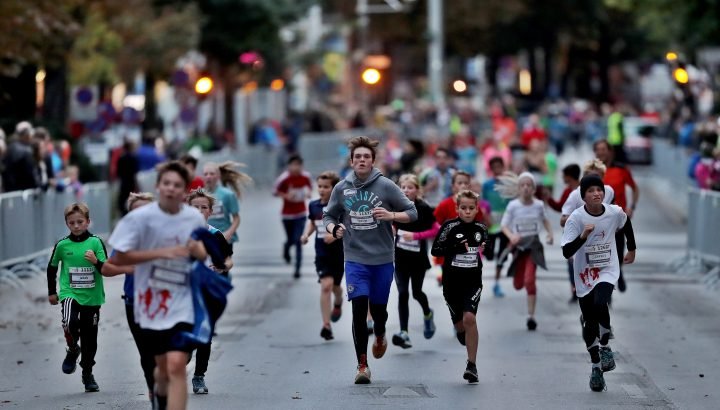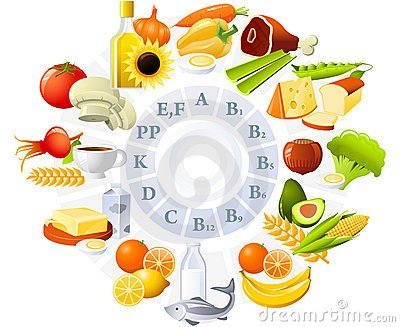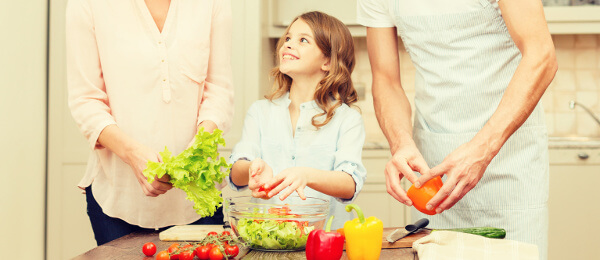
The nutritional information in all media is increasing steadily – unfortunately, this confuses more than the benefit! Nutrition is actually quite simple if you understand your own body and know how it works.
The human body needs energy around the clock, which it derives from daily food. How much we actually consume is up to us. Our bodies are what we eat, drink and inhale … and so our children’s bodies become what we offer them to eat.
The basal metabolic rate describes the amount of energy that a body (needs) if it would only lie for 24 hours, i.e. for body functions such as heartbeat, breathing and brain function. Any further movement requires muscle work and therefore an additional need for energy. The basal metabolism depends on age, gender and muscle percentage – i.e. the more muscles in the body, the higher the basal metabolic rate. The higher the basal metabolic rate, the more energy can be supplied through food without damaging consequences. Body composition is therefore more important for health and performance than weight or the body mass index.
Unfortunately, the basal metabolic rate is reduced by dieting and irregular eating and the metabolism is reduced, which causes a mismatch between intake and consumption. The reason for this is the deterioration of the body composition, since the muscle percentage mostly decreases and the fat content remains.
Children should be able to develop well, grow and master the daily challenges in life. The nutrients in our food are used for this. They need a lot of vitamins, building materials and energy just for development processes and growth. In addition, children and adolescents have a natural urge to move. If this is lived out, the daily energy requirement increases many times, often even more than in adults. But energy is not the same as energy! Every day, high levels of performance are demanded from children or adolescents, which the parents must first be aware of in order to adequately cover them.
Muscles consist of 70% water and require regular stimulation in order to grow. Building 1 kg of muscles often takes months, and losing them takes just a few days. Muscles that are not used regularly are broken down by the body. The breakdown begins within 72 hours, so movement should take place every 2 (at the latest 3 days) to avoid muscle loss. In addition to water, proteins, energy, vitamins and training are needed to “build” muscles. Without stimuli there is no "need" to change anything. There is no way to change anything without energy. Vitamins are in large quantities in e.g. Finding vegetables – the simple tip “to consume different colors” helps to supply the body with different ingredients.
The appropriate amount of protein has been controversial for years – what does an “athlete” need in protein? Previously, amounts of 3g protein per kg body weight were gait and give. There have been many cases of kidney damage and kidney failure because excess protein is excreted through the kidneys. Unfortunately, this amount can hardly be achieved with natural foods, which suggests that supplements and nutritional supplements were used to help. Today, an amount between 1-1.7g is recommended. Daily consumption of protein sources is essential: fish, eggs, lentils, beans, chickpeas, curd cheese and meat are all Examples of protein-containing foods.
As parents, providers and role models, we have a significant influence – for good and for bad. Everything that we set aside for our children often imitate them and later pass it on to their children.
Taste, for example, develops like walking or learning to speak! Only regularly eaten food influences the later nutrition of the children. Nevertheless, attention should be paid to variety so that the adolescents always get to know new foods. But don’t give up straight away if it doesn’t "taste" the first time. A taste has to be "tried" 10 times, then it can only be decided whether the taste is liked or not. There is also the basic rule that 40 different foods should be eaten per week to ensure the necessary variety. Spaghetti, penne pasta and lasagna sheets count as one! The vegetable and salad department offers variety, with a mixed salad (consisting of, for example: tomatoes, cucumber, iceberg lettuce, bird salad, eggs, olives, feta cheese and tuna) and a wok vegetable pan you can already get 16 different foods ( consist of: carrots, onions, garlic, zucchini, broccoli, soybean sprouts and meat / shrimps with rice). One thing is clear: once written down, it will become increasingly difficult to reach 40, the foods mentioned above must not be counted again.
Basically, food can be divided into two groups. "Healthy" is what brings our body what: good energy, building materials or nutrients for our immune system. “Unhealthy” are foods with no sense for our body. no vitamins, no proteins and no minerals. The parents should make a "reasonable" pre-selection from which the children can choose. That clearly starts with the purchase: your own household should be “clean”, not hygienically, but in case the children are at home alone. In case of hunger you should be allowed to eat from all cupboards, WITHOUT having any consequences. If the purchase is limited to "good" food (instead of heavily processed foods) and consequently only these foods can be found at home, then there is no need to worry. Unfortunately, you always think you have cookies and cakes at home for the guests who might come to visit at some point … it is NEVER bought for yourself, but the stock is suddenly gone … but you can not ask children for anything, what one itself does not!
The responsibility lies with the parents until the health awareness of the young people is so great that they can make the decisions themselves. Children who love sports are often more goal-oriented and develop personal responsibility for their body and nutrition earlier.
Author:
Eva Wildauer, nutritionist at the Vorarlberg Olympic Center
There is a series of parent workshops in the Vorarlberg Olympia Center, the aim of which is to impart the necessary knowledge to the participants / parents so that the topic of nutrition can be “easier” to implement again. All parents want the best for their children – but what’s actually the best !? Education instead of further information – create clarity to enable children to enjoy food.
RELATED ITEMS
-

The combination of exercise and nutrition … .. Nutrition and exercise are two of the most important building blocks for a healthy life. A child who cares a lot…
-

Vegan nutrition in children – what to consider, vegan guide
Parents who eat vegan often have the desire to also feed their children plant-based. To date, however, no meaningful information has been provided…
-

Healthy food in daycare and crèche
Healthy nutrition in the crèche is a hot topic. Especially if the parents of your creche have breakfast and lunch for theirs…
-

Neurodermatitis nutrition – what to look for, kanyo®
Eggs, milk and peanuts are the most common culprits when it comes to food allergies. Certain foods are also found in neurodermatitis…
